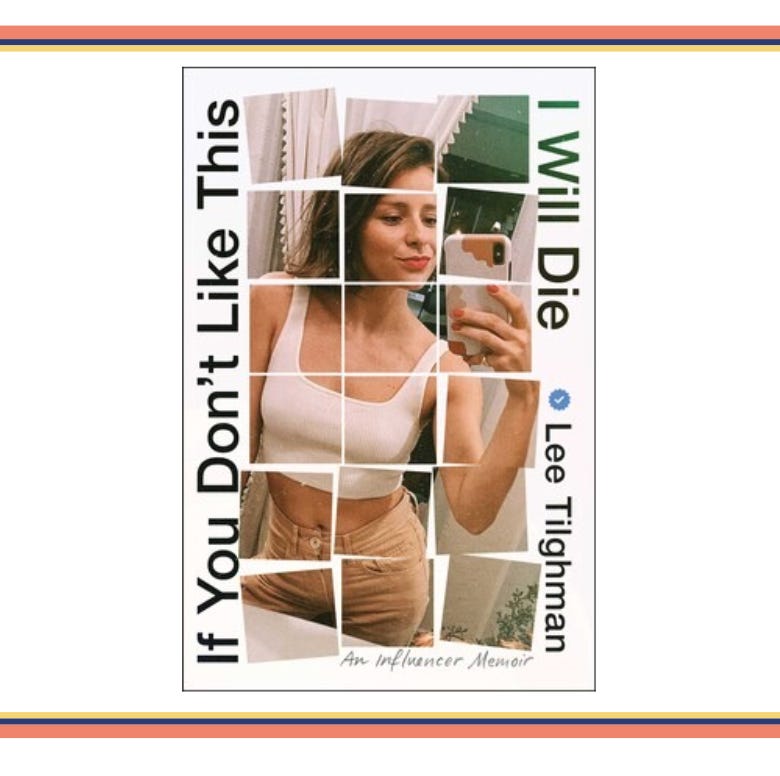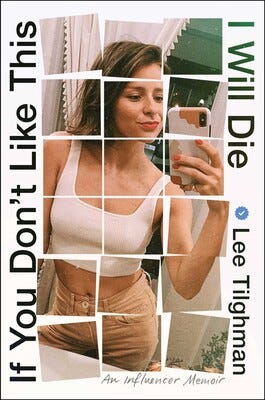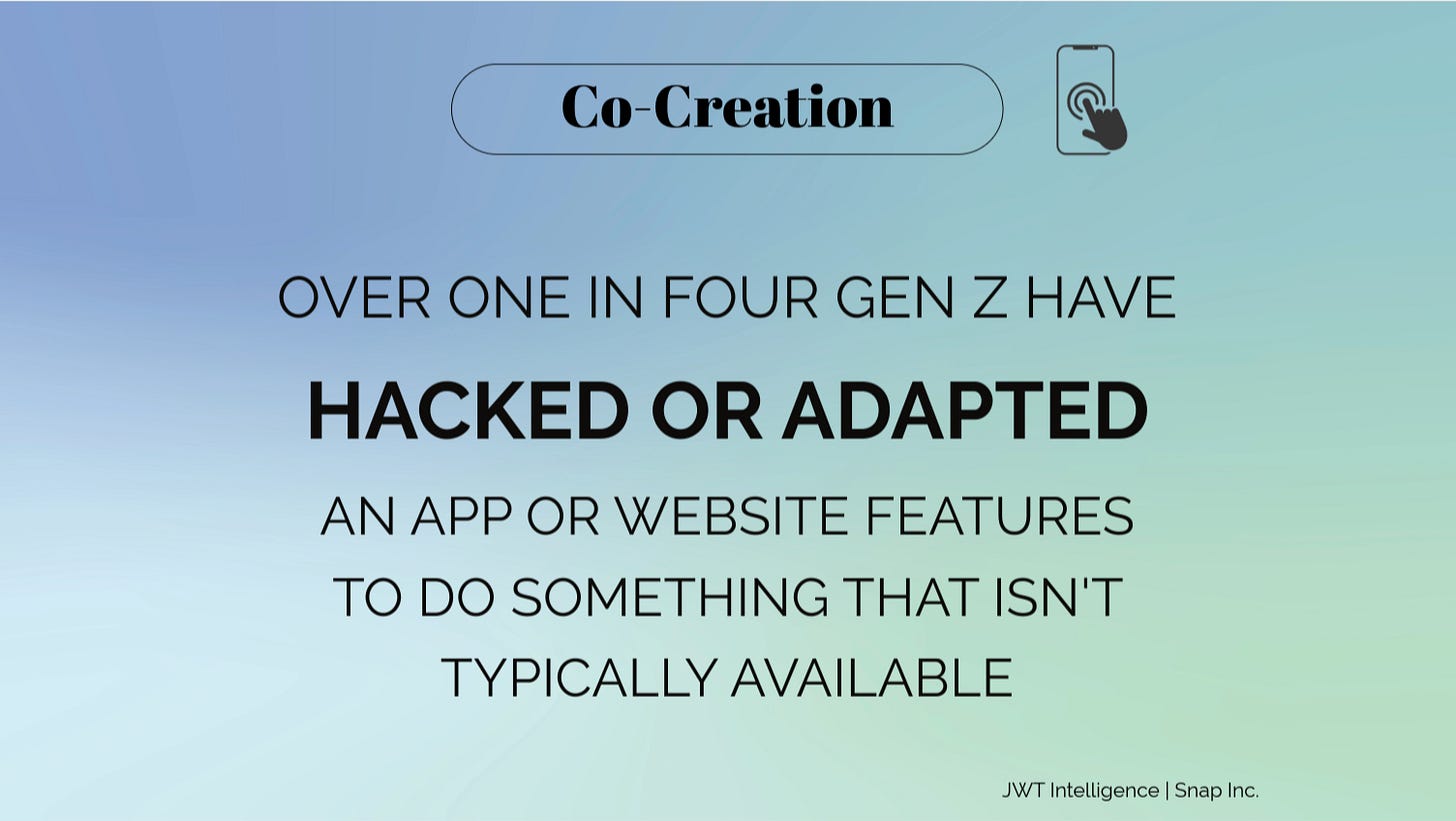ICYMI: Life After Influencing — What Happens Next?
A conversation with former influencer Lee Tilghman
You guys are the best. Thanks to everyone who responded and sent emojis last week — 🦘👋🏽 ❤️ 👍🏻 🪼 😉 🖐🏼 😍 🦥 🥳 😭 🩷 ͏🐿️ 👍🏻 — I seem to be back in your inboxes instead of your spam folders but keep the emoji coming if you’re feeling inspired 😄
Paid subscribers, watch out for an extra email on Monday written by the amazing Katie Steckly: 5 Steps to Develop Your YouTube Content Strategy. I hope it’s useful!
⏰ 1-SECOND SUMMARY
Instagram is testing a dislike button for comments
Facebook will delete livestreams after 30 days
A new YouTube test allows creators to leave voice replies to comments
Reddit is introducing paywalls on exclusive content later this year
Amazon killed it’s TikTok-like content feed
Data: 51% of creators say it’s harder to build a fan community today than 5 years ago
Insight: Four traits that popular TikTok creators share
Report: See 34 Instagrammers dominating the creator middle class
Interview: Influencer-turned-author, Lee Tilghman, talks about life after influence and why newsletters are a healthier outlet than social media
Scroll all the way down for some thoughts from the Adobe Express Summit ⬇️
💻 ROADMAP
📲 Meta Updates
Instagram is testing a new dislike button. It’s meant to give feedback on a particular comment. “Our hope is that this might help make comments more friendly on Instagram,” said Instagram head Adam Mosseri.
Instagram announced several updates to the DM experience, including:
Translation in 99 different languages
The ability to schedule DMs
QR codes to invite friends to group chats
Music stickers in DMs
Instagram announced a new "Testimonial" ad format. These are text-only endorsements from eligible creators that can be pinned to the top of comments on brand ads.
Starting Feb. 19th, Facebook announced it was changing its Live video storage policies. All live videos older than 30 days will be removed from Facebook.
Meta is accepting sign-ups to write and rate Community Notes on Facebook, Instagram, and Threads — which replaces its third-party fact-checking program.
📲 TikTok Updates
TikTok is looking to expand its Live shopping broadcasts in more regions, such as Japan and Brazil.
TikTok announced a new automotive ads category, saying 56% of TikTok users watch reviews and discover new vehicle models on the platform.
TikTok is reportedly planning to make cuts to its global trust and safety team.
📲 YouTube Updates
YouTube is testing a new feature that would allow creators to leave voice replies to comments.
YouTube added a “Promote” button on Shorts to allow creators to boost their videos to be shown to viewers more likely to engage with the promoted channel.
📲 LinkedIn Updates
LinkedIn released a 43-page guide to hosting live events on its platform.
Spotted: LinkedIn newsletters analytics just got an upgrade, adding data about Email Sends and Email Open Rate.
📲 Reddit Updates
Reddit’s CEO confirmed the platform would introduce paywalls for exclusive content later this year.
📲 Amazon Updates
Amazon is shutting down Inspire, its TikTok-style feed for discovering products. The feature sparked controversy back in 2023 when Amazon invited creators to post for only $25 per video.
📖 LIFE AFTER INFLUENCING: AN INTERVIEW
Have you ever wondered about life after influencing? Lee Tilghman upcoming book, If You Don’t Like This, I Will Die (Simon & Schuster), explores the highs and lows of being an influencer. In our conversation, we talked about why she left influencing — back when she was known as Lee From America — how she found stability outside the internet, and her advice for marketers and creators today. Plus, we dig into the realities of writing — both her book and her Substack newsletter — and why she finds long-form storytelling a healthier, more sustainable creative outlet than Instagram.
▶️ ICYMI: How about that title? Full disclosure, I have not seen the book yet so please set the scene for us?
Lee Tilghman: It is an extreme title. The book is about identity, online fame, what happens when you step away from the internet. What I lost when I was at my peak; what I found when I left; and how I'm redefining myself. I really wanted a title that got at the core of what I was really struggling with back then, which was validation and being liked.
Where I grew up, being liked is the most important thing in your life — being liked by men, being liked in the workplace, being liked by your friends. And I didn't find Instagram that different. So, you know, I would die without those likes. Not to mention, how your likes are tied to how much money you get paid. My bank account was based on how much I was liked.
▶️ We worked together back in your influencing days (2017-2018?). The last time I saw you was at a baby goat yoga session. We even flew your mom in for it. Those seem like weird and very artificially manufactured times — but how do you remember that time of your life?
LT: I did so many of those kinds of things around that time, it was just another work day for me. I really didn't think very much of it. But watching my mom come and — even still to this day — she would probably call it one of her favorite days. She got her makeup done. She got flown to L.A. That's not something that my mom gets a lot.
So, I look back at it now, and yes, it was manufactured, but I really focus on how it made my mom's day. So, artificially manufactured times, 100 percent. I probably would have never gone to goat yoga, but the way that it made my mom feel was a gift.
▶️ Do you think things in the influencer marketing industry have gotten better or worse since then?
LT: I haven't really been interacting with influencer content, so I feel a little bit like a granny coming in with her cane. ‘What are all the young kids doing?’ One thing that I do notice, though, I feel like Gen Z came in and they just were wanting to tear down the fake, hyper-curated Instagram flat-lay content of the 2010s. And the 2020s have brought a new group that is more transparent and less bullshit.
But still, even if you go viral for being authentic and transparent and lifting the veil, then you're stuck being a transparent, veil-lifting influencer. You get stuck in these little niches. And you're still having to make two or three videos a day. The burnout can still come.
▶️ Can you give me a timeline of how you went from being an LA wellness influencer, to a mental health facility, to author in New York?
LT: Oh, wow. I have come a long way. But also you think, ‘Oh my god, she was institutionalized.’ But it's important for anyone else who's struggling out there, those places can get you out of a really dark place. And that's where I was, in a really dark place. And I needed to get out of my darkness and figure out a different way of living. So I checked myself into a mental health facility right after getting offline, because I was not well and I rebuilt from there.
It took a long time, I didn't all of a sudden go from the mental health facility to being an author in New York. There were a lot of different hats I tried on. I tried to come back a couple times. For a while I felt like I was too healthy for social media. I honestly was like, ‘I've done way too much therapy to be on here. I can't.’ I needed more time and space.
I just don’t think seven months, eight months was enough time. I needed years.
I went back to work. I went back to getting a nine to five. I went back to school for a little bit. That ended up not being my path. And I always knew I wanted to write a book.
▶️ Wait, that cracks me up, you had too much therapy to be on social media?
LT: A therapist told me that once. She said, ‘You know, Lee, I just think you're too healthy for this.’ For a while, my Instagram was really negative. And she said, ‘You're working in a toxic workplace. You have got to get out of there. You would never put up with that if you were going into work every day and you were getting bullying comments. So why are you showing up?’
▶️ A description on the Simon & Schuster website says the book is for anyone who has struggled with the unreasonableness of online expectations. Talk to me about those online expectations and where they came from?
LT: One thing that I've learned is that criticism is part of being public. So if I'm going to be public and share stuff, I'm going to get criticized. People were mad at me for leaving. People were happy that I left. People were mad that I came back. They were happy that I came back. Especially as a woman, you are going to get criticized no matter what. So you just have to do what feels best for you.
▶️ I saw a post that said: “It's been 5 years since she "quit social media"? And she still doesn’t have a real job.” Which… of course, influencing was a real job.
LT: When people say, ‘Oh, influencing is not a real job.’ It's just a way of silencing — mostly — women, right? It's, ‘How can I cut this person off so that what they say is invalid?’
Of course, it's a real job. My friends who are influencers are the hardest working people I know, so I love it when I see my influencer friends succeed. I know how hard I worked while I was influencing, it was non-stop, around the clock.
▶️ You’re writing a Substack newsletter alongside your book — is writing your favorite form of content creation?
LT: I started creative writing in college. My first blog was called For the Love of Peanut Butter. That was active from 2008 to 2009. Writing has always been a way of self expression.
What I love about Substack is that it's longer form, and I feel like I can express ideas a little bit more slowly and quietly and really percolate on them. Whereas Instagram is more instant, like, boom, boom, boom. Substack is a little bit quieter and slower. And people who engage with me there are usually more intentional. They want a little bit more nuance. Where Instagram is more hot takes.
I also think that starting that Substack really helped me define the ideas of what the book would be. In the beginning I wrote a piece called, My Job Is to Please You, about what it was like being an influencer and I was percolating on these ideas.
▶️ How did you split the time between writing your newsletter and writing your book - what did those days look like?
LT: It hasn't been an easy road. I wish I could say, ‘In the morning I did my newsletter. In the afternoon, I did the book.’ When I was working on the proposal before selling the book, I was doing both. And I was able to do both because there wasn't a deadline, but then as soon as there was a deadline, it was hard.
I don't know how some people can write a best seller and have a thrice weekly Substack. I don't have a team. It's just me. One thing I had to look at is, this book is going to be forever, it's going to have an ISBN and be in the Library of Congress, so that was my priority.
▶️ Influencer marketing is even more relevant now than it was 7 to 8 years ago. What’s your advice for marketers working in the industry; how do they make it a positive experience for influencers?
LT: That's why I'm so excited for this book, because it's not a takedown of influencers. It's so easy to just blame one thing, like, ‘OK, social media gave me an eating disorder.’ There was a lot of cultural, genetic, societal, political situations happening that all culminated into a perfect storm. I hope that people understand, I don't think that being an influencer is a toxic thing and that all influencers are deeply unhappy. I think I was too young at the time to realize what I was getting myself into.
▶️ For fellow influencers and creators — what’s your advice for avoiding burnout and unreasonable online expectations?
LT: I've always been drawn to sharing my inner parts with the world, it's just something that I really love. But as I grew and got more and more obsessed with growing, I stopped hanging out with my friends in person, and then eventually they all stopped asking me to hang out. I stopped being grounded in reality. I was so untethered to the planet, you could have blown and I would have blown over.
So, I would say, “Stay grounded. Stay rooted. You need your family, a close friend, a long term partner, to have that offline, real support. People who know you in real life. So you can go outside, touch grass, get some sun, and be like, ‘Alright, I'm tethered to the world.’”
If You Don’t Like This, I Will Die by Lee Tilghman (Simon & Schuster) comes out August 12, 2025
🧮 DATA OF THE WEEK
51% of creators say it’s harder to build a fan community today than five years ago
- Patreon’s new State of Create research report just dropped on the state of the creator economy and the value of core fans — because “if you don’t own the fan relationships, then ultimately they’re not your fans. They’re just the platforms’ users.”
👀 ICYMI: JUST THE HEADLINES
Meet the 34 Instagrammers dominating the creator middle class: nano (1k-10k), micro (10k-50k), and mid-tier (50k-500k) -Creators Trailblazing to the Top List; American Influencer Council
Gen Z teens tell us why they stopped trusting experts in favor of influencers on TikTok -Fortune
TikTok grabs market share from Shein despite the looming risks -Bloomberg
Why Slow Ventures raised $60 million to invest in creator businesses -Business Insider
the death of capital letters: why gen z loves lowercase -The Guardian
Dick’s Sporting Goods is expanding a program to work with young athlete creators -Adweek
Target’s Black History Month posts slammed as ‘performative’ and ‘gaslighting’ -Retail Brew
Popular TikTok creators tend to post more content; post more regularly; produce longer posts; and talk more in their videos -Pew Research Center
Everyone’s talking about this MrBeast podcast with Diary of a CEO’s Steven Bartlett -YouTube
Thanks for reading!
☝🏻 ONE MORE THING
I led a session on Gen Z social trends at the Adobe Express Summit this week — talking about the platform’s they’re hanging out on, the content formats they’re using, and the trends they’re adopting. Thanks to Kate Olmstead and the Adobe community and social teams! There was one slide that really hammered home some conversations I’ve been having around co-creation. Let me know if this fits with what you’re seeing?
Co-creation is a key part of Gen Z’s experience online.
They don’t just consume culture — they remix and redefine it.
It’s why we see platforms like Instagram (Remix and Sequence), TikTok (Duet and Stitch) and YouTube (Remix) build native collaboration features to enable their creativity.
Or how Instagram encourages Gen Z to put their creative stamp all over the app’s surfaces with Notes (because let’s be honest, Notes are for Gen Z. They use them at 10x the rate of other generations).
Nothing is off limits. It isn’t simply a matter of disabling Remixes or video downloads. Gen Z will just screenshot or screen record the content and use it anyway
If they can't alter something — they will find a work around.
“Over one in four Gen Z have hacked or adapted an app or website features to do something that isn't typically available,” according to this report from JWT Intelligence in partnership with Snap Inc.
The lesson here isn’t “How do we compete with Gen Z creators?” You can’t. It’s “How do we learn from them?”
And then how do you build experiences that invite participation, collaboration and co-creation. It’s the only way for brands to stay a part of the cultural conversation.
OK, now I’m done. Thanks for reading and have a great weekend!








Hi Lia! Super interested in that linkedin live events guide but the link is broken - could you reshare?